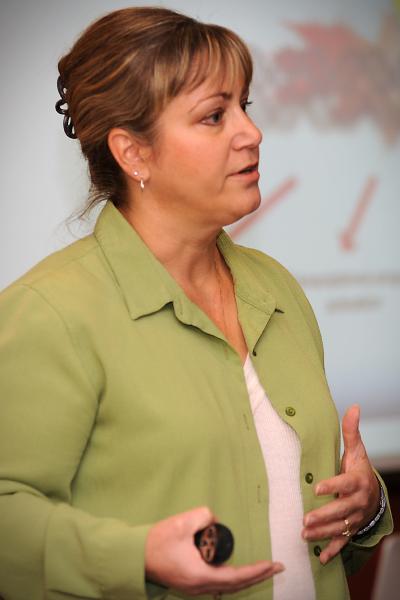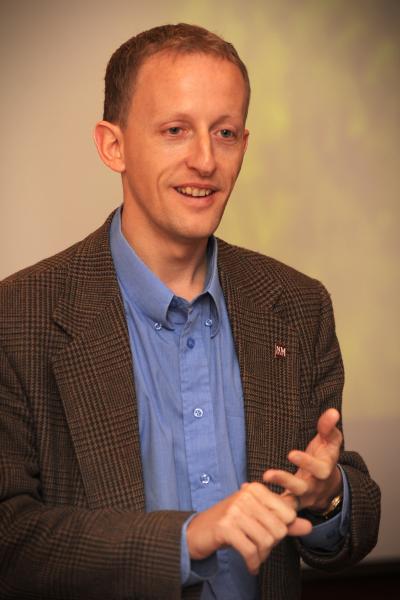NMSU professors discuss solar physics, DNA repair at Research Rally


New Mexico State University celebrated the accomplishments of College of Arts and Sciences faculty members James McAteer and Shelley Lusetti at a Research Rally held Friday, Dec. 6.
McAteer, assistant professor of astronomy, has received a $750,000 Faculty Early Career Development (CAREER) award from the National Science Foundation to fund his project INSPIRE, INtegrated Solar Physics program In Research and Education.
His work examines the sun and its activities, including how energy is stored and released on the sun. McAteer will use the grant to fund interdisciplinary projects for graduates and undergraduates in science and engineering. He is also working with collaborators at NASA.
"The sun is plasma, and it's very hard to study in a lab because it's so hot.
It is a complex subject that moves and evolves in various ways," he said. "In order to learn why it works the way it does, we need to take the data and be able to break it down into different subsets so we can understand little bits at a time and then build it all back up again. That was the goal."
McAteer's research interests include fundamental solar physics, advancement through the design of high-cadence imaging and high-resolution spectroscopy instruments and the sun's relationship to Earth.
"My research is focused on applying new techniques to study the solar sources of space weather - solar flares, coronal mass ejections and the solar wind," he said. "My major areas of study are space weather monitoring and solar cycle studies, understanding the physics of solar flares and coronal mass ejections and the heating of the solar atmosphere."
Because of the complexity of his work and subject matter, McAteer's project partially relies on student research. With the assistance of colleagues, he said he hopes to establish a public database publishing the results of various research projects involving the sun. He described the work as an opportunity to get the public "intimately involved," without needing supervision from academics.
"One person cannot do it all; it's too much data," he added. "We need people to extract data, manage data and do analysis. It works across colleges, across departments, from undergraduates to faculty, combining all these subjects."
The five-year grant will help develop a long-lasting integrated research and education program in solar physics at NMSU, involving the general public, local schools, and NMSU students in learning about the sun, focusing on the key components of complexity and dynamics of coronal heating and solar flares.
"It is a massive career milestone," McAteer said. "Science funding is getting harder and harder to win, and so this award really sets up the solar physics group to concentrate on research, and builds up the national reputation of our research here at NMSU."
Lusetti, associate professor in the Chemistry and Biochemistry Department, has received an R01 grant of $1.3 million from the National Institute of General Medical Sciences, one of the National Institutes of Health, to study "Repair of Damaged Chromosomes Mediated by the Bacterial RecN Protein" over the next five years.
Her research involves mechanisms at the molecular level and could help explain why some cells become resistant to ionizing radiation, which causes damage leading to DNA double-strand breaks. Ionizing radiation uses include food supply sterilization, as well as cancer treatment. If cancer returns, however, it is often resistant to radiation therapy.
"Cells are frequently damaged and what we study is the enzymes that repair that DNA, and try to figure out exactly what their molecular function is," Lusetti said. "We're trying to reconstitute pathways that repair DNA by taking the individual proteins out of the cell. Until we understand the basic mechanism of DNA repair, we cannot understand why some diseases occur - especially diseases such as cancer."
The information for cells to function is encoded in DNA, which is constantly threatened by damaging agents. RecN is a protein critical to DNA repair and maintenance. Lusetti explained that long-term effects occur when there is a problem with the repair processes.
"We are trying to understand how cells become resistant to radiation," she said. "Sensitivity to radiation varies by organism. We happen to be very sensitive to radiation but a lot of bacterial organisms are resistant to radiation. One of our favorite model organisms is Deinococcus radiodurans, one of the most DNA-damage resistant organisms known."
Lusetti is monitoring the relationship between RecN and RecA, another protein essential to DNA maintenance.
In her presentation, Lusetti credited several current and former students for their contributions to the project - especially Lee Uranga, Emigdio Reyes and Praveen Patidar for collecting the data for the grant.
"One of the aims of our work is to reconstitute entire pathways in-vitro so we can specifically assign functions to particular proteins. That is the overall goal of this grant. We have already started to put a lot of these proteins together. We should have a general model of the initial steps of combinational DNA repair out within the next few months."
The Office of the Vice President for Research hosts a series of Research Rallies each semester to inform the community about New Mexico State University's research successes and contributions. The purpose of the rallies is to honor faculty and staff investigators for significant, externally funded projects and demonstrate the impact of NMSU's research efforts across the state and beyond.


